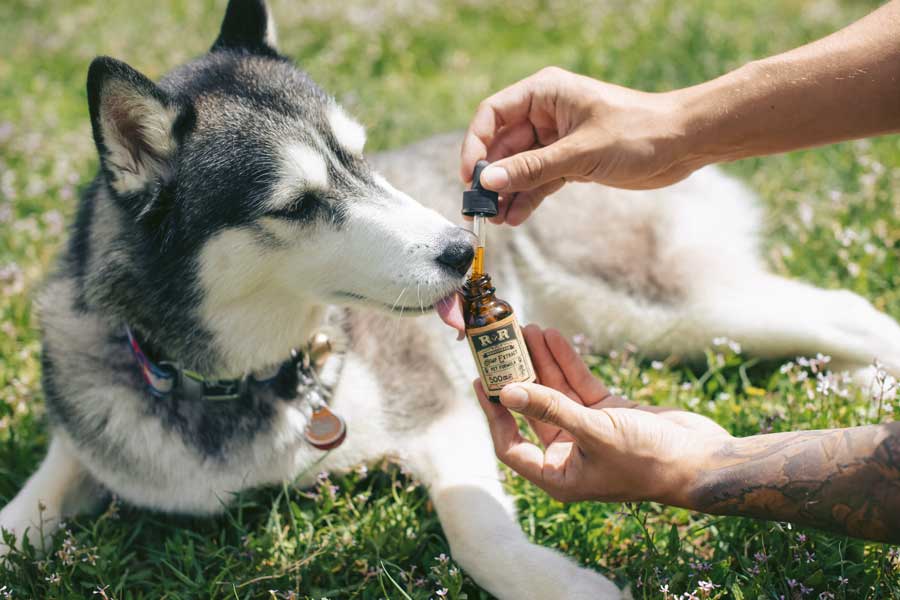It is inevitable that at some point in your dogs life they will be in pain. We hope to break down the signs to look for to know your dog is in pain and offer options to answer the common question “what can you give a dog for pain relief”!
They say that a dog is one of the most loyal domestic animals which is why people owning them tend to develop emotional bonds with them. When they are not feeling well or are in pain, you of course want to do everything possible to take that pain away. The challenge while dealing with dogs in pain is that, unlike humans, they cannot tell you where they are experiencing discomfort – you need to know when they are acting differently which is how they show pain and illness.
Dogs, in particular, have a tendency to hide their pain/distress from their owners. I know this first hand – when my dog Riley was diagnosed with an ACL injury – and it wasn’t until she was limping horrible that I knew something was wrong!
To counter this challenge having regular medical checkups for your dog is a great step in preventing them from feeling the pain. But if you take a moment to learn more about the signs of pain your dog may feel and options for helping at home – you can help both of you feel better!
How Do I Know If My Dog Is in Pain? – Common Signs to Watch Out For
Even though they may try to hide it – there are typically signs your dog is hurting and we are going to talk about those below.
Changes in Body Language
A simple way to know when your dog is suffering is the change in bodily behaviors. As humans, it is normal to feel some discomfort when experiencing pain in certain parts of the body. A common sign of discomfort is limping. When experiencing pain around the limb area, the dog will be reluctant to apply the full weight while walking, hence the limp.
On the other hand, your dog will also express other abnormal body language when experiencing pain. The following are some of the changes to look out for.
- Abnormal hiding of certain body parts
- The dog is reluctant to touch or rebels your approach
- Minimal enjoyment of physical affection shown towards it.
Abnormal Increase in Sounds the Dog Produces
When the pains become unbearable for your dog, it may be compelled to express it. You can tell this through an increase in the sounds it produces. Common pain sounds it may produce include growling, barking, whining and groaning. This is also a good indicator that you should take it to the clinic for checkups.
Increased Aggression
Pain may cause a friendly dog to start being aggressive. You should be concerned when the pet becomes aggressive to your touch. Aggression can be observed through snapping or biting when the affected area is touched. Therefore, it is important to take precautions when examining injuries or pain in your dog.
Changes in Breathing Patterns
Panting is a behavior that is commonly associated with exertion in canines. It only becomes problematic when the intensity increases. Unless after exercising, the breathing and panting of a dog should be quite normal. When it changes, you should make an effort to visit a vet.
Loss of Appetite
If your dog is in excess of pain, the symptoms may escalate. When you notice this sign, it is time to urgently visit your vet. In most cases, loss of appetite is associated with major illnesses or extreme pain levels. Certain mannerisms to look out for include difficulties while chewing, which would indicate dental pains.
Will Every Dog Show Pain In The Same Way?
Unfortunately, no. So, if you have multiple dogs in the home each one may exhibit their pain in different ways. Certain breeds of dogs also have a much higher pain threshold than others so you may not see the signs until they are in extreme pain.
A dog’s ear infection may have less signs of pain than a torn knee – so the signs of pain will vary greatly depending on the issue. If you are unsure of why they are in pain – then you should definitely visit a vet to rule out any severe medical issues.

So, now that you know what to look for we can talk about some options for helping them feel better. Below are options for at home pain relief and some medicines that a veterinarian may prescribe.
If your dog is showing extreme pain – if they are yelping or whining consistently, limping or not applying any weight on a limb for example – please go strait to the vet to ensure there is nothing very wrong!
Natural Pain Relief Options For Dogs
When your dog is experiencing pain, you have to find ways to relieve it. Sometimes you may notice the symptoms of pain when it is late in the night and you cannot rush to the vet. Other times you may prefer to relieve the pain before visiting the clinic. In such a case what dog pain relief home remedy options are available?
Fish Oils
More often than not, a dog experiencing joint pains may be a result of arthritis. When this is the case, it would be advisable to hinge your bet on fish oil as an effective home remedy. To most pet owners, it is a very good source of omega-3 fatty acids (DHA and EPA).
These are a good natural anti-inflammatory, which makes them effective in the management of pain. Fish oils are also remedies to other conditions such as kidney illness.
Vitamin C Supplement
If you are a serious dog person, chances are that you have a little medicine cabinet. At some point, your vet may have also recommended the dog Vitamin C as a supplement. When experiencing pain, the ascorbate forms of vitamin C are good relievers.
CBD Oil
Cannabidiol is becoming one of the highly researched organic compounds in the medical arena. Its study is mainly centered around being used as a drug for several medical conditions such as anxiety, heart disease and depression. Most recently it has been identified as a good pain reliever for both people and dogs.
Turmeric
This is one of the common spices in most homes. The good thing about it is that you can conveniently acquire it from your grocery stores. What you do not probably know is that it contains a number of anti-inflammatory substances. Research has shown that they are good at minimizing pain both in humans and dogs.
Glucosamine/Chrondroitin
Very popular for people for helping with joint pain – these two are commonly known to show some help in alleviating swelling and even repairing cartilage. Basically these are meant to help repair joint damage and can be effective in aging dogs.
When you take your dog to the vet, chances are that there will be a prescription of pain medication. Some of these drugs can also be obtained over the counter. In that case, it is important to discuss some pain meds for dogs and what they do.
Can I Give My Dog Over The Counter Human Pain Relief?
The short answer is no, you should never give your pet OTC pain medications without consulting your vet.
One of the most common misconceptions is that you can just give your dog aspirin or ibuprofen to help relieve their pain – but you should never give them these items without consulting with your veterinarian. Your veterinarian may say go ahead and give your dog aspirin – but having that conversation instead of just going ahead and giving them aspirin can save your pet a lot of anguish!
Below are the 2 most common types of over the counter pain relief options:
Aspirin/Tylenol are pain and fever reducers you can obtain over the counter and should never be given to your pet without talking to your veterinarian first. It should only be used as a remedy for short-term conditions and emergencies. While these can be given to dogs in very small doses, there are risks and not every dog can tolerate it so you may wind up doing more harm than good.
Ibuprofen like Advil or Motrin are also pain relievers and also have anti-inflammatory benefits – but these should NEVER be given to your dog! These medications pose great risks and can be very toxic.
Naproxen should also never be given to your dog.
Veterinary Prescribed Pain Relief For Dogs
What your veterinarian prescribes for your dogs pain will vary greatly depending on your dogs’ health, age, breed, size and more. Common prescription medicines include Carprofen which is in the ibuprofen category and is sometimes also known as Rimadyl.
If those give your dog too many side effects your vet may try other options like Previcos, Deramaxx, Tramadol and more. These are usually less risky for side effects like ulcers or internal bleeding.
Working with your vet is critical if your dog is in pain. There is no “easy way” to fix the problem and if you handle it on your own without consulting with your vet, you can be putting your dog at greater risk and bring them more pain.
Dealing with Your Dog’s Pain
If you realize your dog is in pain – remember you are not alone! It is quite normal for your dog to experience pain resulting from injuries or other illnesses at some point – and I know how heartbreaking it can be to see them hurting.
What matters is how soon you realize the distress and how quickly you deal with it.
Watch out for the above common ways to know when your dog is pain and the available remedies for dealing with it and before you know it you will have your happy, healthy – pain free dog again!


